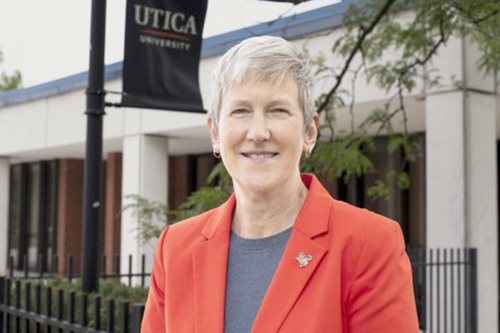Get our email updates
Stay up-to-date on the companies, people and issues that impact businesses in Syracuse, Central New York and beyond.
What's New
Upcoming Events
CNYBJ Job Board

Utica engineering firm is under new ownership
UTICA, N.Y. — Eisenbach & Ruhnke Engineering, P.C., an engineering firm based in Utica, is now under the ownership of Joseph C. Lu Engineering, PC, dba Lu Engineers, a Rochester–based engineering firm with offices in the Syracuse area and Binghamton. With Lu Engineers expanding its presence to Utica, the firm will “gain stronger access to […]
Get Instant Access to This Article
Become a Central New York Business Journal subscriber and get immediate access to all of our subscriber-only content and much more.
- Critical Central New York business news and analysis updated daily.
- Immediate access to all subscriber-only content on our website.
- Get a year’s worth of the Print Edition of The Central New York Business Journal.
- Special Feature Publications such as the Book of Lists and Revitalize Greater Binghamton, Mohawk Valley, and Syracuse Magazines
Click here to purchase a paywall bypass link for this article.
UTICA, N.Y. — Eisenbach & Ruhnke Engineering, P.C., an engineering firm based in Utica, is now under the ownership of Joseph C. Lu Engineering, PC, dba Lu Engineers, a Rochester–based engineering firm with offices in the Syracuse area and Binghamton.
With Lu Engineers expanding its presence to Utica, the firm will “gain stronger access to local and municipal markets and increase capacity to support projects throughout the Utica region,” per the Lu Engineers announcement.
The acquisition closed on Oct. 19, Lu Engineers tells CNYBJ in an email. The firm didn’t disclose any financial terms of the purchase.
Prior to the deal, Lu Engineers had 102 employees and is adding eight staff members from Eisenbach & Ruhnke Engineering.
Eisenbach & Ruhnke brings a team of engineers, scientists, specialists, energy managers and auditors who provide advanced energy and environmental engineering solutions in areas that complement Lu Engineers’ established strength in civil/site, transportation engineering and environmental consulting. The acquisition enables Lu Engineers to pursue “larger and more complex” projects throughout New York state and to diversify projects to include mechanical, electrical and plumbing (MEP) engineering services.
“We’re a small firm but a mighty firm that keeps growing every day. The acquisition is a strategic opportunity for us and impactful to our growth,” Cletus Ezenwa, president and CEO of Lu Engineers, contended in the announcement. “Lu Engineers has a great reputation for transportation and environmental projects, and expanding our capabilities to support mechanical, electrical and plumbing (MEP) services will enable us to serve on a broader scale and deliver even greater value to our clients.”
Lu Engineers is a veteran-owned, New York State-certified Disadvantaged and Minority-owned Business Enterprise. For more than 45 years, Lu has provided engineering, technical, and operational services to federal, state, and local governments, as well as private industries and developers.
“We are excited to become part of Lu Engineers; a firm committed to quality and serving its clients,” Jack Eisenbach, former CEO of Eisenbach & Ruhnke Engineering, P.C., said in the announcement. “Eisenbach & Ruhnke Engineering has been in existence for almost 40 years, and we have worked with many engineering firms. Our staff is committed to maintaining the quality of service for the clients of the combined firm.”
Eisenbach also tells CNYBJ that the transaction represents a succession plan after 39 years of owning the business, but he plans to continue working for two years part time as a senior associate.
Besides Rochester, DeWitt, and Utica, Lu Engineers also has offices in Buffalo and New York City.

Two Syracuse law firms to combine to become Costello Cooney Fearon & Fetter
SYRACUSE, N.Y. — The Syracuse law firms of Costello, Cooney & Fearon, PLLC and Scolaro Fetter Grizanti & McGough, P.C. are looking ahead to the new year when they will officially combine and become Costello Cooney Fearon & Fetter. “Costello Cooney Fearon & Fetter will build upon a combined 175 years of legal tradition in
Get Instant Access to This Article
Become a Central New York Business Journal subscriber and get immediate access to all of our subscriber-only content and much more.
- Critical Central New York business news and analysis updated daily.
- Immediate access to all subscriber-only content on our website.
- Get a year’s worth of the Print Edition of The Central New York Business Journal.
- Special Feature Publications such as the Book of Lists and Revitalize Greater Binghamton, Mohawk Valley, and Syracuse Magazines
Click here to purchase a paywall bypass link for this article.
SYRACUSE, N.Y. — The Syracuse law firms of Costello, Cooney & Fearon, PLLC and Scolaro Fetter Grizanti & McGough, P.C. are looking ahead to the new year when they will officially combine and become Costello Cooney Fearon & Fetter.
“Costello Cooney Fearon & Fetter will build upon a combined 175 years of legal tradition in Syracuse while establishing a stronger foundation to serve clients across the region and beyond,” the firms contended in their announcement.
Costello, Cooney & Fearon currently operates at 211 W. Jefferson St. in the Jefferson Clinton Commons building, located near the MOST. Scolaro Fetter Grizanti & McGough currently operates at 507 Plum St. in Syracuse’s Franklin Square area.
The Costello firm tells CNYBJ in an email that even though their names won’t be part of the combined firm’s name, attorneys Anthony Grizanti and Stewart McGough are remaining with the combined firm. The Costello firm also indicated the late Richard Scolaro died back in 2015.
As of Nov. 3, Costello, Cooney & Fearon has 37 attorneys and 37 staff members, while Scolaro Fetter Grizanti & McGough has eight lawyers, with an additional attorney joining the combined firm as of Jan. 5, 2026, along with 13 staff members, per the email response from the Costello firm.
From advising local businesses and municipalities to guiding families through generations of change, both “firms share a common history of helping the region grow and thrive,” they say.

“Bringing our firms together unites the collective strength of two highly successful practices with a shared vision for delivering the highest quality client service,” Jeffrey Fetter, CEO of Scolaro Fetter Grizanti & McGough, said in the announcement. “This combination will allow us to offer a broader range of legal services to meet the evolving needs of our present and future clients.”
The combined law firm will offer “expanded strength” in litigation, business and tax law, mergers and acquisitions, estate and trust planning and administration, municipal and education law, real estate, family law, health care, and agricultural law.
Initially, the combined law firm will operate from the 211 W. Jefferson St. location with a satellite office at 507 Plum St., but everyone will eventually be moving to the West Jefferson Street location, the Costello firm tells CNYBJ.
As of Nov. 3, Costello, Cooney & Fearon has offices in Syracuse, Cazenovia, and Albany, while Scolaro Fetter Grizanti & McGough has offices in Syracuse and in Stuart, Florida. The combined Costello Cooney Fearon & Fetter will operate offices in Syracuse, Albany, and Cazenovia, as well as Stuart, Florida.
“This is an important and exciting moment for both of our firms. Combining with Scolaro Fetter Grizanti & McGough strengthens the services we can provide to our clients and creates new opportunities for our attorneys and staff,” John Langey, CEO of Costello, Cooney & Fearon, said.

Turning Stone Evolution project to open sooner than expected
VERONA, N.Y. — The Turning Stone Evolution expansion project is moving along faster than expected with the Crescent Hotel and Salt Seafood & Raw Bar now expected to debut next summer on June 29, 2026. And the Grand Expo will open shortly after that on Labor Day 2026. The Turning Stone Evolution, a $370 million
Get Instant Access to This Article
Become a Central New York Business Journal subscriber and get immediate access to all of our subscriber-only content and much more.
- Critical Central New York business news and analysis updated daily.
- Immediate access to all subscriber-only content on our website.
- Get a year’s worth of the Print Edition of The Central New York Business Journal.
- Special Feature Publications such as the Book of Lists and Revitalize Greater Binghamton, Mohawk Valley, and Syracuse Magazines
Click here to purchase a paywall bypass link for this article.
VERONA, N.Y. — The Turning Stone Evolution expansion project is moving along faster than expected with the Crescent Hotel and Salt Seafood & Raw Bar now expected to debut next summer on June 29, 2026.
And the Grand Expo will open shortly after that on Labor Day 2026. The Turning Stone Evolution, a $370 million investment, was initially anticipated to open in 2027. The Oneida Indian Nation calls the Evolution its “largest ever reinvestment” into Turning Stone Resort Casino.
The Nation has partnered with architecture and design firm Gensler. General contractors for the project, the Hayner Hoyt Corporation of Syracuse and TN Ward Company, Builders of Ardmore, Pennsylvania have overseen a vast network of subcontractors throughout construction to keep the project effort ahead of schedule.
“The Turning Stone Evolution is a transformational investment in bringing new people to Upstate New York and giving them reasons to return,” Ray Halbritter, Oneida Indian Nation representative and Turning Stone Enterprises CEO, said in the announcement. “Everything the Evolution is creating will allow us to compete with some of the top tourism and events markets in the country — destinations like New York City, Chicago, Orlando, and more — and demonstrate what we have always known about Upstate New York: that we have everything these destinations offer and more.”
Project elements
The expansion includes the Crescent Hotel, which brings 258 new guest rooms and suites to accommodate guests for business and leisure travel. The hotel will offer a dedicated entrance and check-in, as well as indoor connectivity to The Grand Expo, restaurants, the Event Center, the Showroom, and the gaming floor.
Booking for the Crescent Hotel will begin in early 2026, per the announcement.
The new hotel will be home to a new restaurant called Salt Seafood & Raw Bar. In addition to a main dining area and raw bar, the restaurant also has private dining rooms with heated terraces.
The Turning Stone Evolution also includes a new 1,600-space parking garage, doubling existing indoor-parking capacity at the resort, and an on-site medical center that will serve Turning Stone employees, their families, and resort guests.
When The Grand Expo opens in early September, it will expand Turning Stone’s conference and event spaces to 200,000 square feet of modern meeting rooms, making it New York’s largest meetings and conventions resort, the Oneida Indian Nation contends.
The Grand Expo will be home to two ballrooms, including the Grand Ballroom, an elevated space that may be configured in numerous ways and that includes an outdoor terrace that can accommodate close to 2,000 guests.
Among the outdoor spaces created by the Turning Stone Evolution, a new 25,000-square-foot courtyard will be situated at the center of the Grand Expo’s meeting rooms.

Colgate expands Colgate Commitment initiative
HAMILTON, N.Y. — Students in families that have a total annual income of up to $175,000 could be able to attend Colgate University tuition free, under a new university offer. In addition, those students with family incomes of up to $200,000 will have their demonstrated aid need met without loans starting in the fall of
Get Instant Access to This Article
Become a Central New York Business Journal subscriber and get immediate access to all of our subscriber-only content and much more.
- Critical Central New York business news and analysis updated daily.
- Immediate access to all subscriber-only content on our website.
- Get a year’s worth of the Print Edition of The Central New York Business Journal.
- Special Feature Publications such as the Book of Lists and Revitalize Greater Binghamton, Mohawk Valley, and Syracuse Magazines
Click here to purchase a paywall bypass link for this article.
HAMILTON, N.Y. — Students in families that have a total annual income of up to $175,000 could be able to attend Colgate University tuition free, under a new university offer.
In addition, those students with family incomes of up to $200,000 will have their demonstrated aid need met without loans starting in the fall of 2026.
Both elements are part of the school’s expansion of the Colgate Commitment, the university’s pledge to increase access and affordability, first launched in 2020.
The new income level for eliminating tuition more than doubles the no-tuition threshold that was established when Colgate first introduced the initiative. In addition, the expansion increases the number of students for whom a federal loan will not be part of their financial-aid offer. It also adjusts the percentage of tuition for which families are responsible based on new income brackets, Colgate said.
“Expanding the Colgate Commitment opens the doors of this world-class University to more exceptional students from all walks of life,” Colgate University President Brian Casey said in the announcement.
The expansion marks the third time that Colgate has worked to broaden the scope of the aid initiative, which it describes as a “critical part” of the University’s Third-Century Plan. The last update, announced in 2022, included expansion of aid packages to meet the average cost of textbooks and other academic expenses.
Beyond helping those with the greatest level of need, this expansion also targets in the middle and upper-middle income brackets. Families with an annual income between $175,000 and $200,000 will, on average, now pay 5 percent of their income toward tuition. Families with annual income levels between $200,000 and $250,000 will, on average, now pay 7 percent of their income toward tuition, and those with incomes of $250,000-$300,000 will pay, on average, 10 percent of their income toward tuition, Colgate said.
“Applying for financial aid can feel complicated and overwhelming,” Gina Soliz, senior associate dean and director of financial aid, said. “This expansion of the Colgate Commitment helps simplify the financial aid process and increases the number of students who will benefit from having loans replaced with Colgate grants.”

Chemung Financial reports improved earnings in Q3
ELMIRA, N.Y. — Chemung Financial Corporation (NASDAQ: CHMG), parent company of Chemung Canal Trust Company, recently reported that its net income jumped 37 percent to $7.8 million in the third quarter from $5.7 million in the year-ago quarter as its balance sheet and margins improved. The banking company’s earnings per share increased 36 percent to
Get Instant Access to This Article
Become a Central New York Business Journal subscriber and get immediate access to all of our subscriber-only content and much more.
- Critical Central New York business news and analysis updated daily.
- Immediate access to all subscriber-only content on our website.
- Get a year’s worth of the Print Edition of The Central New York Business Journal.
- Special Feature Publications such as the Book of Lists and Revitalize Greater Binghamton, Mohawk Valley, and Syracuse Magazines
Click here to purchase a paywall bypass link for this article.
ELMIRA, N.Y. — Chemung Financial Corporation (NASDAQ: CHMG), parent company of Chemung Canal Trust Company, recently reported that its net income jumped 37 percent to $7.8 million in the third quarter from $5.7 million in the year-ago quarter as its balance sheet and margins improved.
The banking company’s earnings per share increased 36 percent to $1.62 per share from $1.19 a share in the same period, the banking company said.
“Third quarter results demonstrate the importance of the Corporation’s balance sheet repositioning efforts undertaken over the past two quarters. Net interest income growth of $1.9 million, or approximately 9% compared to the prior quarter, reflects the immediate positive impact these actions have had on earnings by enabling continued investment in quality loan opportunities while simultaneously managing funding costs,” Anders M. Tomson, president and CEO of Chemung Financial, said in the Oct. 21 earnings report. “These results affirm the strategic direction we’ve taken and the disciplined execution of our strategy by our team across all of our divisions. With strong pipelines in key markets and a continued focus on relationship banking, the Corporation remains well positioned to deliver long-term value for our clients, communities, and shareholders.”
Net interst income, expense
Chemung Financial’s net interest income for the third quarter of 2025 totaled $22.7 million, compared to $18.4 million for the same period in the prior year, an increase of 23.4 percent. It was driven by gains in interest income on loans and interest income on interest-earning deposits, along with a decline in interest expense on deposits, partially offset by a drop in interest income on taxable securities.
Interest income on loans at Chemung Financial increased largely due to a rise of $151.4 million in average balances of total loans, compared to the same period in the prior year, as well as an increase of 3 basis points in the average yield on total loans, compared to the prior-year period. The increase in average balances of total loans was concentrated in commercial loans, which rose $183.3 million compared to the year-earlier quarter, largely comprised of growth in commercial real estate, particularly in Chemung Financial’s Capital region and Western New York markets.
The average yield on commercial loans decreased 7 basis points compared to the same period a year ago, largely due to declines in benchmark interest rates on existing variable rate loans and the lower market interest-rate environment for new loans, the banking company noted.
Chemung Financial’s average balances of residential mortgage loans increased by $4.3 million and the average yield on residential mortgage loans increased 41 basis points, compared to the prior-year quarter. The increase in average balances of residential mortgage loans was largely due to stronger origination activity year-to-date in 2025 compared to a year earlier. However originations remain below typical historical levels, the banking company stated.
Average balances of consumer loans at Chemung Financial fell by $36.2 million in the third quarter versus a year prior, while the average yield on consumer loans increased by 5 basis points compared to the year-earlier quarter. The decline in average balances was largely due to normal portfolio turnover and lower origination activity in the indirect auto-portfolio segment, as Chemung Financial has continued prioritizing funding other types of lending during the past year, per the earnings report.
Interest income on interest-earning deposits increased in the third quarter, largely due to a rise of $64.3 million in average balances of interest-earning deposits, despite a decrease of 50 basis points in the average yield on interest-earning deposits, each compared to a year before. Average balances of interest-earning deposits increased primarily due to proceeds from Chemung Financial’s sale of available-for-sale securities and issuance of subordinated debt in the second quarter of 2025, net of payoffs of wholesale funding sources in this year’s third quarter and funding of commercial-loan growth.
Interest expense on deposits at Chemung Financial fell in the third quarter, mainly due to declines of $58.7 million in average balances of brokered deposits and $47 million in average balances of customer time deposits, as well as decreases of 104 and 88 basis points in the average cost of brokered deposits and customer time deposits, respectively, compared to last year’s third quarter. Average balances of brokered deposits decreased due to the banking company’s payoff of all outstanding balances of brokered deposits during July 2025, as part of its balance-sheet repositioning efforts, the earnings report stated. The dip in the average cost of brokered deposits compared to a year ago was largely due to the declining interest-rate environment, which Chemung Financial benefited from by largely utilizing brokered deposits with terms of three months or less.
Chemung Financial reported that its fully taxable equivalent net interest margin was 3.45 percent for the third quarter of 2025, compared to 2.72 percent in the same period in 2024. Average interest-earning assets decreased by $82.3 million, while average interest-bearing liabilities fell by $104.7 million, compared to the prior-year quarter, both primarily due to the net impact of the banking company’s balance-sheet repositioning efforts.
The average yield on interest-earning assets increased 37 basis points to 5.15 percent in the third quarter, while the average cost of interest-bearing liabilities fell 46 basis points to 2.51 percent, compared to a year before. The total cost of funds was 1.85 percent in the latest quarter, compared to 2.24 percent for the third quarter of 2024.
Provision for credit losses
Chemung Financial took a provision for credit losses of $1.1 million in this year’s third quarter, up from $600,000 in last year’s third quarter. The increase was mostly due to stronger loan growth in the third quarter of 2025, which totaled $69.9 million, compared to loan growth of $17.5 million for the same period in the prior year, and adjustments to model inputs between the third quarters of 2024 and 2025, per the earnings report.
Non-interest income, expense
Non-interest income for the third quarter of 2025 totaled $6.1 million at Chemung Financial, compared to $5.9 million in the same quarter in 2024, driven by increases in other non-interest income and service charges on deposits.
Other non-interest income increased mainly due to higher interest-rate swap fees, reflecting a rise in originations of loans with interest-rate swap exposures in the third quarter of 2025, compared to the same period in 2024. An increase in commission income attributable to the company’s CFS Group and higher service charges on deposit accounts, after phasing in fee-schedule increases, also helped.
Non-interest expense for Chemung Financial in the third quarter of 2025 totaled $17.6 million, up from $16.5 million in the year-ago period, an increase of 6.7 percent, driven by increases in salaries and wages, as well as pension and other employee benefits. That was partially offset by declines in FDIC insurance, as well as other non-interest expense and loan expense.
Salaries and wages at Chemung Financial increased largely due to a rise in base salaries, which included staffing in the banking company’s Western New York Canal Bank division, consisting of additional lending, branch, and wealth-management staff. Merit-based salary increases for existing employees also contributed to the rise. Pension and employee benefits increased largely due to higher employee health-care-related expenses compared to the same period in 2024.
Chemung Financial is a $2.7 billion financial-services holding company headquartered in Elmira. It operates 30 retail branches through Chemung Canal Trust Company, a full-service community bank with trust powers. Established in 1833, Chemung Canal Trust says it the oldest locally owned and managed community bank in New York state. Chemung Financial’s CFS Group, Inc. financial-services subsidiary offers non-traditional services including mutual funds, annuities, brokerage services, tax preparation services, and insurance.

2025 40 Under Forty Event Supplement
Read about the 2025 Honorees in the 2025 Event Supplement – congratulations to this year’s class! Read Here >
Get Instant Access to This Article
Become a Central New York Business Journal subscriber and get immediate access to all of our subscriber-only content and much more.
- Critical Central New York business news and analysis updated daily.
- Immediate access to all subscriber-only content on our website.
- Get a year’s worth of the Print Edition of The Central New York Business Journal.
- Special Feature Publications such as the Book of Lists and Revitalize Greater Binghamton, Mohawk Valley, and Syracuse Magazines
Click here to purchase a paywall bypass link for this article.
Read about the 2025 Honorees in the 2025 Event Supplement – congratulations to this year’s class!
Read Here >

Utica University leadership change coming in 2026
UTICA, N.Y. — Utica University will have new leadership in 2026 after current president Todd Pfannestiel submitted his resignation with plans to step down at the end of the 2025 calendar year. The university’s board of trustees has named Stephanie Nesbitt as Utica University’s next president, effective Jan. 1, 2026. Nesbitt has agreed to serve
Get Instant Access to This Article
Become a Central New York Business Journal subscriber and get immediate access to all of our subscriber-only content and much more.
- Critical Central New York business news and analysis updated daily.
- Immediate access to all subscriber-only content on our website.
- Get a year’s worth of the Print Edition of The Central New York Business Journal.
- Special Feature Publications such as the Book of Lists and Revitalize Greater Binghamton, Mohawk Valley, and Syracuse Magazines
Click here to purchase a paywall bypass link for this article.
UTICA, N.Y. — Utica University will have new leadership in 2026 after current president Todd Pfannestiel submitted his resignation with plans to step down at the end of the 2025 calendar year.
The university’s board of trustees has named Stephanie Nesbitt as Utica University’s next president, effective Jan. 1, 2026.
Nesbitt has agreed to serve as president through July 31, 2028, allowing Utica University to begin an orderly search for its next president. That process will start in mid-2027, the university announced.
Pfannestiel joined Utica University in 2018 as provost and senior VP for academic affairs and became president in 2023.

PHOTO CREDIT: UTICA UNIVERSITY WEBSITE
Nesbitt is the current provost and senior VP for academic affairs. Her Utica University career began in 2012 as an assistant professor. Over the years, she has served as director of the MBA and risk management and insurance programs, as well as associate dean and dean of the School of Business and Justice Studies.
Before joining Utica University, Nesbitt spent more than 16 years in risk management and in-house counsel roles in retail and healthcare organizations.
“We are fortunate to have Dr. Nesbitt available to take on this leadership role. Her 13-year history at the University and deep dedication to the University’s mission make her the perfect choice as we move confidently forward,” Jeremy Thurston, chairperson of the Utica University board of trustees, said. “Dr. Nesbitt and the Board of Trustees share a commitment to the investments Utica University is making in programs with strong student interest that support regional and national workforce needs. She is a well-known and respected member of our campus, enjoying good working relationships with internal and external university stakeholders.”
Utica University said Pfannestiel has played a key role during his time leading the school, most recently helping to shape a strategic academic and operational restructuring at a “challenging time” for U.S. higher education. The board of trustees “appreciates Dr. Pfannestiel’s willingness to take on tough assignments with grace and wishes him well in his future endeavors.”
“Utica University announced a restructuring on July 1 to strengthen the University for the future. The result of an extensive dialogue with a variety of faculty, staff, academic leaders and regional employers, this forward-looking vision is rooted in the values that define Utica University,” Thurston said. “Colleges and universities across the country face demographic and economic shifts. Utica University is acting with prudence and foresight. Dr. Nesbitt will shepherd the critical changes underway to help better align our cost structure to revenue and position Utica University to grow to a student population of 3,750.”
Thurston went on to say, “Since we announced this restructuring plan, the Trustees have received many unsolicited pledges of support and affirmation for the decision to focus on a core academic portfolio of professional, pre-professional and STEM [science, technology, engineering, mathematics] offerings … We are committed to a practical approach that is responsive to student interests and employer needs, fueling growth for people, companies and communities. Working together we will evolve to meet the challenges before us and thrive by producing career-ready graduates.”

SU’s Whitman School to offer new master’s degree in real estate in 2026
SYRACUSE, N.Y. — Syracuse University’s (SU) Martin J. Whitman School of Management plans to offer a master’s degree in real estate, starting in the fall of 2026. Building on Whitman’s undergraduate real-estate program, the new master’s degree offers dedicated real-estate education related to development, finance, and sustainability. The one-year, on-campus program takes a finance and
Get Instant Access to This Article
Become a Central New York Business Journal subscriber and get immediate access to all of our subscriber-only content and much more.
- Critical Central New York business news and analysis updated daily.
- Immediate access to all subscriber-only content on our website.
- Get a year’s worth of the Print Edition of The Central New York Business Journal.
- Special Feature Publications such as the Book of Lists and Revitalize Greater Binghamton, Mohawk Valley, and Syracuse Magazines
Click here to purchase a paywall bypass link for this article.
SYRACUSE, N.Y. — Syracuse University’s (SU) Martin J. Whitman School of Management plans to offer a master’s degree in real estate, starting in the fall of 2026.
Building on Whitman’s undergraduate real-estate program, the new master’s degree offers dedicated real-estate education related to development, finance, and sustainability.
The one-year, on-campus program takes a finance and sustainability-focused approach to real estate. Students have access to faculty experts, hands-on learning, and a nationwide network of Syracuse alumni working across the industry. The program is STEM-designated, which allows international students to apply for a 24-month optional practical training (OPT) extension. STEM is short for science, technology, mathematics, and engineering.
“We are excited for the future of real estate, and this new specialized master’s degree is the next step for our already excellent program,” Alex McKelvie, interim dean of the Whitman School, contended in an announcement. “The face of real estate has changed dramatically in recent years, moving toward a model where a background in finance, business analytics, entrepreneurship and environmental sustainability are vital components. This new program, combined with Syracuse’s proximity to major hubs like New York City, positions Whitman to create added value and drive job-ready professionals into the real estate industry.”
Students can complete the 30-credit program in one calendar year with flexibility for students who prefer a longer timeline. Students will take specialized real-estate courses, alongside electives in areas such as sustainability, infrastructure, and real-estate law, which reflect the evolving needs of the industry, according to Milena Petrova, professor of real estate and finance and director of the real-estate program at the Whitman School, said.
Students will also engage in a group capstone project, “Green Real Estate Competition: Doing Well by Doing Good,” which will leverage real-estate data, modeling and analytical capabilities as students take part in a simulated competition on “green” real estate stock selection as part of their experiential learning.
“Graduates of the program will be well-prepared to pursue careers across the real estate industry, including development, investment analysis, capital markets, corporate real estate, private equity and asset and portfolio management,” Petrova said.

More than 350 companies celebrated as Economic Champions by CenterState CEO
SYRACUSE, N.Y. — The efforts of 353 businesses and nonprofit organizations were recognized on Oct. 29 during CenterState CEO’s annual Economic Champions Celebration at the Nicholas J. Pirro Convention Center at Oncenter in downtown Syracuse. Those involved were honored for their contributions to the “growth and vibrancy” of the Central New York economy. Nearly 600
Get Instant Access to This Article
Become a Central New York Business Journal subscriber and get immediate access to all of our subscriber-only content and much more.
- Critical Central New York business news and analysis updated daily.
- Immediate access to all subscriber-only content on our website.
- Get a year’s worth of the Print Edition of The Central New York Business Journal.
- Special Feature Publications such as the Book of Lists and Revitalize Greater Binghamton, Mohawk Valley, and Syracuse Magazines
Click here to purchase a paywall bypass link for this article.
SYRACUSE, N.Y. — The efforts of 353 businesses and nonprofit organizations were recognized on Oct. 29 during CenterState CEO’s annual Economic Champions Celebration at the Nicholas J. Pirro Convention Center at Oncenter in downtown Syracuse.
Those involved were honored for their contributions to the “growth and vibrancy” of the Central New York economy. Nearly 600 community members attended the event.
Together, the honored organizations were recognized for their aggregate hiring of more than 4,800 employees, over 1.3 million square-feet of expansions, and more than $1.4 billion in capital investments.
CenterState CEO went on to say that “in a sign of positive economic momentum,” 94 businesses were recognized for opening new storefronts, offices, and facilities; 88 were highlighted for celebrating a milestone anniversary; 156 were recognized for receiving significant awards and achievements and 44 organizations and firms were noted for advancing diversity, equity, and inclusion in their workplaces and community.
Companies are nominated as Economic Champions by CenterState CEO, the Greater Oswego-Fulton Chamber of Commerce, the Downtown Committee of Syracuse, Inc., peers, employees and staff, as well as self-nominations.
“During this year’s Economic Champions event we celebrate and reflect on the magic that occurs when preparation meets opportunity. All the successes we recognized today didn’t happen overnight. It is the product of decades of determination and collaboration. Together, we put in the work so that when opportunity came knocking, this region would be ready,” Robert Simpson, president and CEO of CenterState CEO, said in the announcement. “This event brings together leaders from every sector — builders, creators, visionaries — people who believe in the promise of this place. Their dedication has not only powered a true economic transformation in this region, they are also looking ahead and steadfastly preparing to turn today’s aspirations into future achievement. That is what champions do, and that is why this event exists–to celebrate those driving impact today and for tomorrow.”
Felisha Legette-Jack, head coach of the Syracuse University women’s basketball team, served as the event’s keynote speaker.
“I am blessed to return to my roots in Central New York and witness first-hand the fresh path of growth and possibilities for the future,” said Legette-Jack. “As we strive for success together, our ability to perform will always be tied to our ability to take care of ourselves and each other, both physically and mentally. If we are mentally strong, we can be physically ready to take on any challenge and overcome them for a better future. It is a gift to be home and to be a part of this wonderful community and I look forward to celebrating all of our achievements along the way.”
Community Visionary Award
The Economic Champions event also includes the annual recognition of CenterState CEO’s Community Visionary Award, sponsored by Wegmans Food Markets. This year’s honoree was Onondaga Community College (OCC) for its commitment to economic opportunity and community prosperity, CenterState CEO said.
“Onondaga Community College is dedicated to creating stronger outcomes for its students, our community and the entire region,” Evelyn Ingram, Wegmans director of community engagement, said in the CenterState CEO announcement. “OCC understands the critical importance of collaboration, working with employers and partners to design programs that factor in the totality of a student’s experience, including potential barriers to their success. The college actively embraces its role as a forward-looking, instrumental leader, and Wegmans is proud to honor it with this year’s CenterState CEO Community Visionary Award.”
OCC has “taken a lead” in workforce innovation, expanding programs, building community connections, and creating new pathways to careers for youth and adults alike, CenterState CEO said. Its degree and certificate programs in health care, manufacturing, and other tech-related fields provide students with direct-to-work and transfer opportunities. And as part of SUNY Reconnect, OCC plays a “pivotal role” in helping more individuals boost their earning power with a free associate degree in a high-demand field, like advanced manufacturing, health professions and cybersecurity.
CenterState CEO went on to say that OCC has “shown statewide leadership” on semiconductor training and education, “committed to building pathways” to degree programs and in-demand careers for underrepresented individuals. Additionally, investments like the new Micron Cleanroom Simulation Lab on the OCC campus, which opened in October, “create a vital tool” to prepare students for jobs at Micron Technology, Inc. (Nasdaq: MU) and other companies.
Micron will build a semiconductor-manufacturing campus in the town of Clay.
“As regional employers seek skilled talent for high-demand jobs and residents look for access to those growing opportunities, OCC is proud to prepare students for careers that are both essential and rewarding,” Warren Hilton, president of OCC, said. “Whether through our new Micron Cleanroom Simulation Lab, expanded training spaces and programs in health care and other industries, and innovative pathways for adult learners through SUNY Reconnect, we remain ‘lazer focused’ on expanding access to high-quality, affordable education while strengthening the region’s economic growth. This award is a testament to our faculty and staff, and to the community whose support makes our mission possible.”

LeMura to serve as Le Moyne president through June 2028
SYRACUSE, N.Y. — Linda LeMura, who has served as president of Le Moyne College in Syracuse since 2014, will continue leading the college through June 30, 2028. The Le Moyne College board of trustees recently approved the two-year contract extension. Her previous employment agreement was set to run through June 2026. No financial terms were
Get Instant Access to This Article
Become a Central New York Business Journal subscriber and get immediate access to all of our subscriber-only content and much more.
- Critical Central New York business news and analysis updated daily.
- Immediate access to all subscriber-only content on our website.
- Get a year’s worth of the Print Edition of The Central New York Business Journal.
- Special Feature Publications such as the Book of Lists and Revitalize Greater Binghamton, Mohawk Valley, and Syracuse Magazines
Click here to purchase a paywall bypass link for this article.
SYRACUSE, N.Y. — Linda LeMura, who has served as president of Le Moyne College in Syracuse since 2014, will continue leading the college through June 30, 2028.
The Le Moyne College board of trustees recently approved the two-year contract extension. Her previous employment agreement was set to run through June 2026. No financial terms were disclosed.
In December, LeMura will become the longest serving president in the history of Le Moyne, surpassing William Reilly, S.J., who served as the college’s fifth president from 1964 to 1975. LeMura was unanimously appointed by the board as Le Moyne’s 14th president in 2014.
“As the first female layperson to serve as president of a Jesuit college or university in the U.S., it’s fitting that Linda will soon make history as Le Moyne’s longest-serving president,” Chris Curtis, chairman of the Le Moyne College board of trustees, said in the college’s announcement. “Her work over the past 11 years has been stellar, and she has proven time and again to be an innovative, respected and inspirational leader. Linda is a passionate student of the higher education sector, and she has used her knowledge and insights to Le Moyne’s advantage… The trustees look forward to Linda’s continuing leadership and her ability to turn challenges into opportunities for growth and success.”
A first-generation college student, daughter of Italian immigrants, and Syracuse native, LeMura came to Le Moyne as the dean of the College of Arts and Sciences in 2003, serving four years in the role before the college named her provost and VP for academic affairs in 2007. She was provost until becoming president in 2014.
“I am honored to serve as president of this college and work alongside colleagues across campus to transform the lives of so many students through an excellent education in the Catholic, Jesuit tradition,” LeMura said in the college’s announcement. “Much like the past 11 years, Father Reilly’s time leading Le Moyne was marked by great change, not only on the Heights but in the country and the world. As we anticipate an era of significant challenges and opportunities over the next few years, I’m humbled by the faith placed in me by the board to ensure a thriving and resilient future for our entire College community.”
Notable Le Moyne achievements during LeMura’s tenure have included “record-breaking” enrollment and fundraising. She also oversaw the successful completion of the $100 million Always Forward campaign, the largest in the college’s 78-year history, which contributed to growth of Le Moyne’s endowment to more than $300 million, per the announcement. Other highlights include the enrollment of eight “historically large” classes and the 2022 reclassification to Division I intercollegiate athletics.
LeMura also co-chairs the Central New York Regional Economic Development Committee (REDC) and was “actively engaged” in Central New York’s efforts to attract Micron’s microchip-manufacturing facility in the town of Clay, which will result in a $100 billion investment over the next 20 years.
Get our email updates
Stay up-to-date on the companies, people and issues that impact businesses in Syracuse, Central New York and beyond.
